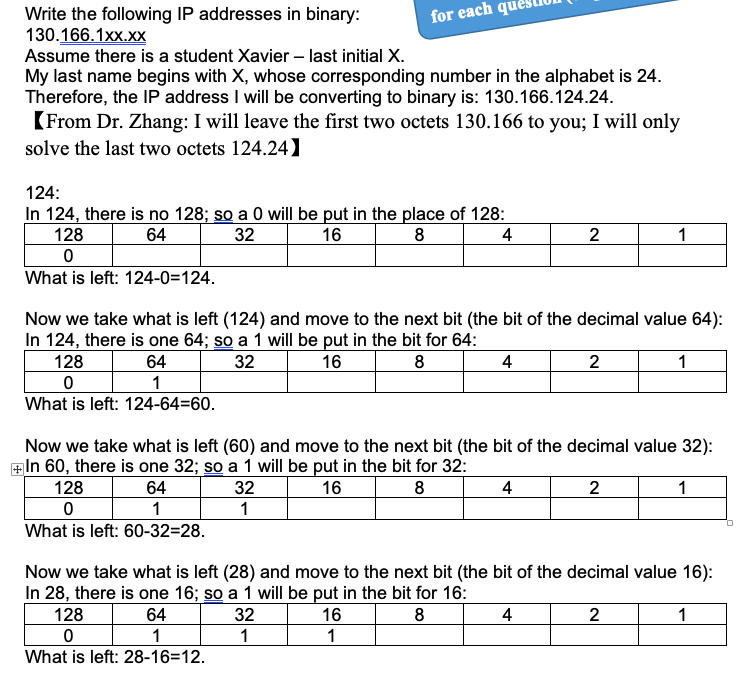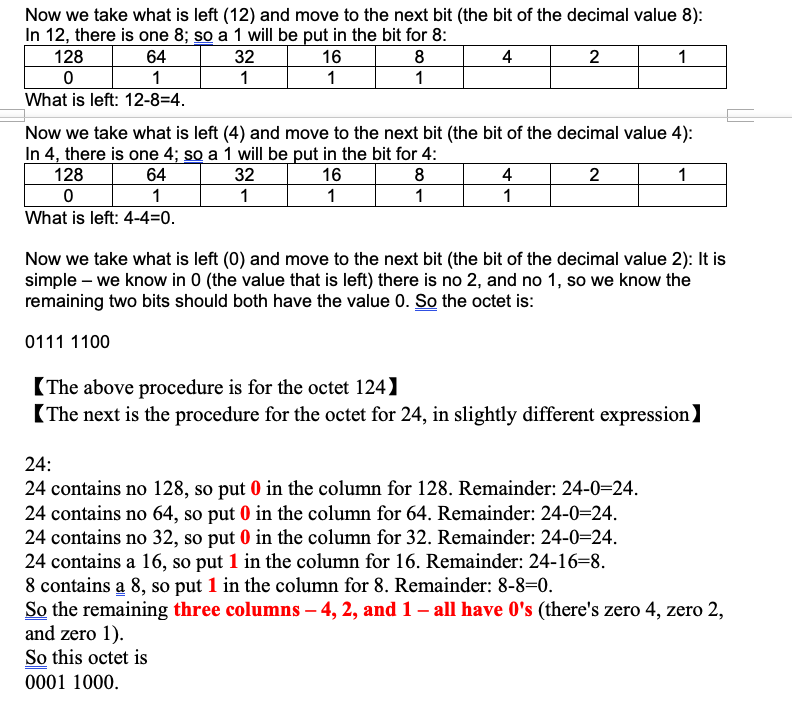How to solve the question? Please follow the sample. Birth month: 01
Problem 2 (4 points). Write the following IP addresses in binary: 192.168.2xx.birth_month Where "xx" has the same meaning as in Problem 1, and "birth month" is a student's birth month (01-12). Follow the bullets "1-2-3" as in Problem 1, changing "last nitial" with "birth month".Write the following IP addresses in binary: for each quest 130.166. 1xx.XX Assume there is a student Xavier - last initial X. My last name begins with X, whose corresponding number in the alphabet is 24. Therefore, the IP address I will be converting to binary is: 130. 166. 124.24. [ From Dr. Zhang: I will leave the first two octets 130.166 to you; I will only solve the last two octets 124.24] 124: In 124, there is no 128; so a 0 will be put in the place of 128: 128 64 32 16 8 4 2 1 0 What is left: 124-0=124. Now we take what is left (124) and move to the next bit (the bit of the decimal value 64): In 124, there is one 64; so a 1 will be put in the bit for 64: 128 64 32 16 8 4 2 0 What is left: 124-64=60. Now we take what is left (60) and move to the next bit (the bit of the decimal value 32): + In 60, there is one 32; so a 1 will be put in the bit for 32: 128 64 32 16 8 4 2 0 1 1 What is left: 60-32=28. Now we take what is left (28) and move to the next bit (the bit of the decimal value 16): In 28, there is one 16; so a 1 will be put in the bit for 16: 128 64 32 16 8 4 2 1 0 1 1 What is left: 28-16=12.Now we take what is left (12) and move to the next bit (the bit of the decimal value 8): In 12, there is one 8; so a 1 will be put in the bit for 8: 128 64 32 16 8 4 2 1 0 1 1 1 1 What is left: 12-8=4. Now we take what is left (4) and move to the next bit (the bit of the decimal value 4): In 4, there is one 4; so a 1 will be put in the bit for 4: 128 64 32 16 8 4 2 1 0 1 1 1 1 What is left: 4-4=0. Now we take what is left (0) and move to the next bit (the bit of the decimal value 2): It is simple - we know in 0 (the value that is left) there is no 2, and no 1, so we know the remaining two bits should both have the value 0. So the octet is: 0111 1100 [ The above procedure is for the octet 124 ] [ The next is the procedure for the octet for 24, in slightly different expression ] 24: 24 contains no 128, so put 0 in the column for 128. Remainder: 24-0=24. 24 contains no 64, so put 0 in the column for 64. Remainder: 24-0=24. 24 contains no 32, so put 0 in the column for 32. Remainder: 24-0=24. 24 contains a 16, so put 1 in the column for 16. Remainder: 24-16=8. 8 contains a 8, so put 1 in the column for 8. Remainder: 8-8=0. So the remaining three columns - 4, 2, and 1 - all have O's (there's zero 4, zero 2, and zero 1). So this octet is 0001 1000









